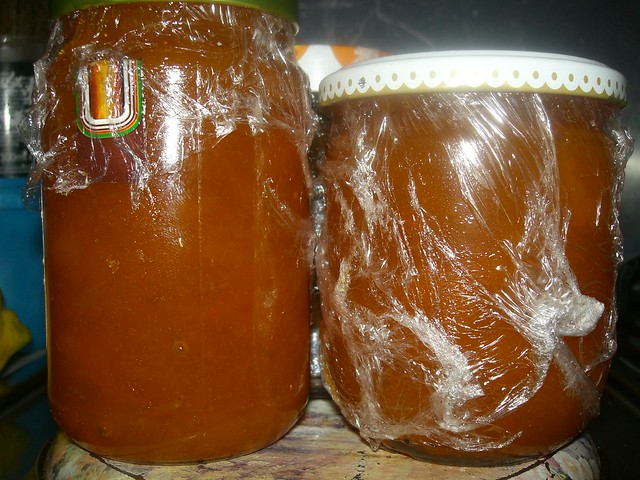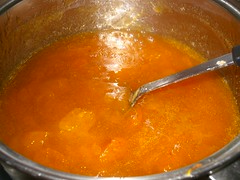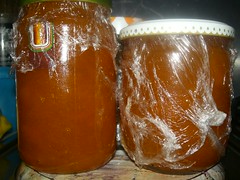"Thank you so much for helping us get rid of this year's excessive (as it always is)
zuchinni crop from our garden. The
chocolate-zucchini cake is in the oven as we speak, and smells wonderful. We've also been knee-deep in
apricots. Jam, yes, and apricot upside-down cake which I think our village neighbours genuinely liked, though I don't think they were so keen on the apricot clafoutis; is it something to do with the passionate
authoritative egalitarian interest which Cretans take in good food, like the French do?"
Having made the
jam and eaten the fresh fruit from our tree, I am still looking for ways to get rid of the apricots left in the fridge. The reason of course is obvious: if we have our own fresh fruit available, it is highly unsustainable to buy other fresh fruit if we have our own. This philosophy is reasonable: apart from eating seasonally as often as possible, it is also more likely that we are imbibing fewer pesticides and more vitamins, hence healthier food. As I can't wait to taste our first watermelon for the season, I have to get rid of those apricots creatively. I'd rather not try juicing them - now that our orange trees are in full production, we make
orange juice every day.
Clafoutis? What on earth is that? And why didn't the
Greek peasant neighbours like it? After all, the French peasants love it. Is it genetic? With the help of the internet, I found out all I could about clafouti (as it's also written). I chose
Martha Schulman's recipe because it sounded the least complicated and didn't use any overly exotic ingredients.

You need:
10-15 apricots, halved and stoned (
the less ripe, the firmer they will stand in the pudding)
2 tablespoons of brandy (
cognac)
1 tablespoon of lemon juice
7 tablespoons of sugar (
my first reaction is:
only?)
3/4 cup milk
1/2 cup yoghurt (
I used some lemon flavoured yoghurt 'given away for free' by a milk company with every carton of its expensive, well over-1-euro per litre milk - I have joined in the boycott against expensive milk in my country)2 eggs (
the recipe said three; I reduced the number, given what I know about how Cretans like their desserts, not too eggy: now I know why the neighbours weren't too keen)
1 vial vanilla powder (
pods and essence are not widely available in Crete)
pinch of salt
2/3 cup of sifted all-purpose flour
icing sugar for dusting (optional)
Place the apricots in a bowl with the brandy, lemon juice and half the sugar to become syrupy (this needs about half an hour). Oil a 10- or 10-1/2-inch ceramic quiche or tart dish. Drain the liquid from the apricots into a bowl, and place the apricots rounded side up in the dish. Using an electric mixer, beat together the syrup, sugar, milk, yoghurt, eggs, vanilla and salt till the mixture is creamy. Slowly beat in the flour. Mix together well. Pour the batter over the fruit. Bake in a moderate oven for 35 to 45 minutes, until the top is browned and the clafoutis is firm. Press gently on the top in the middle to see if it's firm. I omitted the icing sugar bit.
Clafoutis sounds like my kind of dessert - fruit (
usually cherries) in a spongy batter, something like a furity custard. It reminds me of all those fruity puddings that my Kiwi friends' mothers made at their homes. I never got to eat a pudding made by any of them, having to be satisfied with the photos I saw of them in Women's Weekly, and dreaming about what it would be like to eat a dessert that looked like it had been born in a royal kitchen and served to some king or queen, who nodded his or her head to show contentment, while the cook sighed with relief that his head wouldn't be chopped off if since it met with the royals' approval. Last year, I made a spectacular
plum crumble but that's the only time I've cooked fruit in this house. Not that it won't get eaten - it does, but not by anyone else, unfortunately.

Possibly, this dessert might not be too popular with Cretan locals if it's served warm (it hit 37 degrees Celsius yesterday); it will look and feel like baby food, which is probably why my friends' neighbours didn't like it - 'krema' they might've said; 'clafouti yia ton fafouti' (clafoutis for the toothless). Fruity cakes have also never been very popular with some members of my own family. My husband's logic in this is that sweet and savoury never mix, and fruit is served after sweet, which comes after savoury, to clear the palate, so to speak. One way I have successfully helped to encourage the eating of fruity-vegetable cakes (
apple cake,
banana cake,
carrot cake,
walnut cake,
zucchini cake) is to serve these desserts at room temperature with ice-cream. Till he met me, with the exception of
walnut cake, he had never had such cakes. Cooked fruit is usually served in Greece as a pie (in
phyllo pastry).
Serving ice-cream with cake is not as decadent as it may sound - fruit desserts usually don't contain a lot of sugar (hey presto, another reason why they didn't like it, being used to
galaktoboureko and
baklava), as the fruit compensates for its lack of sweetness. This is however another way to
bastardise a local dish: cream (including ice-cream) is a definite no-no with clafoutis. When Alexandra was in France and asked for cream to go with her clafoutis, the homely waitress rasied an eyebrow and replied: "Of course if Madame wishes for cream she shall have cream, but one would normally not take cream with a clafoutis."
I'm not much of an experienced cook in the sense that I haven't a clue about foreign food - anything that's out of the Cretan environment is what the English say (it's all Greek to me). I'm a good eater, but the chance to cook foreign doesn't crop up often enough in my life at the moment, and it's not just to do with sourcing foreign ingredients. I feel I must clarify my position because I don't think I'd make clafoutis again. The apricots in the custard batter were delicious, but maybe this dessert tastes better when
made in the traditional manner using cherries. The recipe stated that it should be served warm, but this is a definite no-no in the Greek climate, as is the idea of cooking fruit. Clafoutis should indeed be served warm (preferably in a cooler climate), as it goes quite thick, like a cold custard, when it cools down. A glass of cold water is a must when eating apricot clafoutis, as it leaves a syrupy residue in the mouth, a little like the traditional Greek sweets my friend's neighbours are used to.
If I had to give this dessert a Greek name, I'd call it the French version of
galaktoboureko served with fruit. But next time, I think I'll stick to apricot upside down cake.
This post is dedicated to all former urbanites who suddenly realised their call in life and became Cretan peasants, before it was too late.
And here is Alexandra's recipe for comparison purposes, in imperial measures:
350 – 450 grams fruit, stoned.
3 eggs
85 grams sugar
75 grams all-purpose flour
Half tsp powdered cinnamon
Half pint milk (560 mill) (you can replace 2 tbsp of it with brandy for a treat)
2 tablespoons melted butter
Little icing sugar to finish
Heat oven to 375F, 190C, Gas mark 5. Butter a big shallow dish (I use a 12 inch flan dish which would be about 30cm, scatter the halved stoned fruit on the base and sprinkle with a tablespoon of the sugar. Beat the rest of the sugar with the eggs, stiur in flour and cinnamon mixed, continue whisking till smooth. Gradually beat in the milk and finally the cool melted butter. Pour batter over the fruit and bake for about 45 mins until puffed up and lightly browned. Best served warm, dusted with icing sugar (and no cream!)
©All Rights Reserved/Organically cooked. No part of this blog may be reproduced and/or copied by any means without prior consent from Maria Verivaki.

 Over the years, we've had many fruit trees in our garden. We used to have peach and nectarine, which both did well, but attracted too many pests, orange (we got tired of it, since we also own orange orchards), loquat (which didn't really do well) and plum, which dried up and died after serving us well for a number of years. Now we have a young lemon, a budding pomegranate and a shrubby lychee tree, while in the same position as the plum tree, there is now an apricot tree.
Over the years, we've had many fruit trees in our garden. We used to have peach and nectarine, which both did well, but attracted too many pests, orange (we got tired of it, since we also own orange orchards), loquat (which didn't really do well) and plum, which dried up and died after serving us well for a number of years. Now we have a young lemon, a budding pomegranate and a shrubby lychee tree, while in the same position as the plum tree, there is now an apricot tree.














